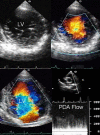Non-compacted cardiomyopathy: clinical-echocardiographic study
- PMID: 17002802
- PMCID: PMC1592122
- DOI: 10.1186/1476-7120-4-35
Non-compacted cardiomyopathy: clinical-echocardiographic study
Abstract
The aim of the present study was to describe the clinical and echocardiographic findings of ventricular noncompaction in adult patients. Fifty-three patients underwent complete clinical history, electrocardiogram, Holter and transthoracic echocardiogram. Forty patients (75%) were in class I/II of the New York Heart Association, and 13 (25%) in class III/IV. Ventricular and supraventricular escape beats were found in 40% and 26.4%, respectively. Holter showed premature ventricular contractions in 32% and sustained ventricular tachycardia in 7.5%. Ventricular noncompaction was an isolated finding in 74% of cases and was associated with other congenital heart disease in 26%. Noncompacted ventricular myocardium involved only left ventricle in 62% of the patients and both ventricles in 38%. The mean ratio of noncompacted to compacted myocardial layers at the site of maximal wall thickness was 3.4 +/- 0.87 mm (range 2.2-7.5). The presence of ventricular noncompaction in more than three segments was associated with a functional class greater than II and ventricular arrhythmia with demonstrable statistical significance by chi2(p < 0.003).
Conclusion: a) Noncompacted cardiomyopathy is a congenital pathological entity that can occur in isolated form or associated with other heart disease and often involves both ventricles. b) A ratio of noncompacted to compacted myocardium greater than 3 and involvement of three or more segments are indicators of poor prognosis. c) Since the clinical manifestations are not sufficient to establish diagnosis, echocardiography is the diagnostic tool that makes it possible to document ventricular noncompaction and establish prognostic factors.
Figures







Similar articles
-
Thickness and Ratio of Noncompacted and Compacted Layers of the Left Ventricular Myocardium Evaluated in 56 Normal Fetuses by Two-Dimensional Echocardiography.Biomed Res Int. 2019 Jan 23;2019:3726846. doi: 10.1155/2019/3726846. eCollection 2019. Biomed Res Int. 2019. PMID: 30809538 Free PMC article.
-
Left ventricular noncompaction cardiomyopathy in end-stage heart failure patients undergoing orthotopic heart transplantation.Cardiovasc Pathol. 2016 Jul-Aug;25(4):293-299. doi: 10.1016/j.carpath.2016.03.004. Epub 2016 Mar 30. Cardiovasc Pathol. 2016. PMID: 27135206
-
Isolated noncompaction of the myocardium: an exceedingly rare cardiomyopathy. A case report.Ital Heart J. 2000 Apr;1(4):301-5. Ital Heart J. 2000. PMID: 10824732
-
[Isolated left ventricular non-compaction].Ital Heart J Suppl. 2005 Oct;6(10):649-59. Ital Heart J Suppl. 2005. PMID: 16273752 Review. Italian.
-
Isolated noncompaction of the left ventricular myocardium -- a review of the literature two decades after the initial case description.Clin Res Cardiol. 2007 Jul;96(7):481-8. doi: 10.1007/s00392-007-0528-6. Epub 2007 Jun 4. Clin Res Cardiol. 2007. PMID: 17534568 Review.
Cited by
-
Noncompaction of the right ventricle.Pediatr Cardiol. 2010 May;31(4):576-8. doi: 10.1007/s00246-010-9652-6. Pediatr Cardiol. 2010. PMID: 20155258 No abstract available.
-
Replacement of a congenital bicuspid aortic valve in a patient with left ventricular noncompaction.Tex Heart Inst J. 2009;36(3):241-3. Tex Heart Inst J. 2009. PMID: 19568396 Free PMC article.
-
Isolated left ventricular noncompaction: what do we really know?Curr Cardiol Rep. 2012 Jun;14(3):381-8. doi: 10.1007/s11886-012-0255-0. Curr Cardiol Rep. 2012. PMID: 22415394 Review.
-
Family screening in black patients with isolated left ventricular non-compaction: the Chris Hani Baragwanath experience.Cardiovasc J Afr. 2020 Jul/Aug;31(4):180-184. doi: 10.5830/CVJA-2020-003. Epub 2020 Mar 11. Cardiovasc J Afr. 2020. PMID: 32159583 Free PMC article.
-
Electrocardiographic findings in correlation to cardiac magnetic resonance imaging patterns for isolated ventricular non-compaction patients.Anatol J Cardiol. 2015 Jul;15(7):556-7. doi: 10.5152/akd.2015.15973. Anatol J Cardiol. 2015. PMID: 26139169 Free PMC article. No abstract available.
References
-
- Ritter M, Oechslin E, Sutsch G, Attenhofer C, Schnider J, Jenni R. Isolated noncompaction of the myocardium in adults. Mayo Clin Proc. 1997;72:26–31. - PubMed
-
- Dusek J, Ostadal B, Duskova M. Postnatal persistence of spongy myocardium with embryonic blood supply. Arch Pathol. 1975;99:312–317. - PubMed
MeSH terms
LinkOut - more resources
Full Text Sources
Medical

